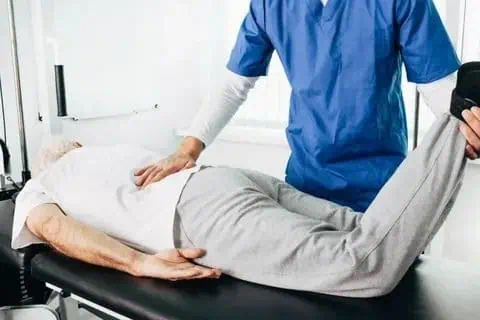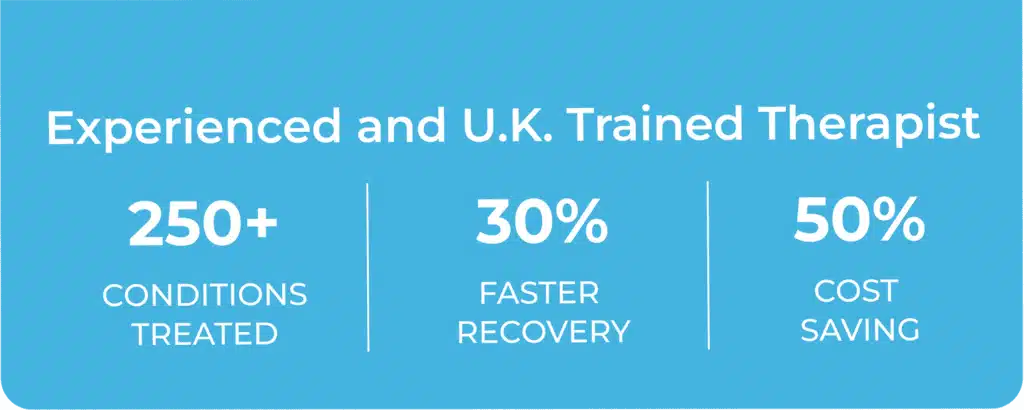
Back pain isn’t just a small problem anymore — it’s something many working professionals and active individuals quietly struggle with every day. For 32-year-old Neha, a school teacher, it began as mild stiffness after long hours of standing. Within weeks, the discomfort spread to her legs, making it hard to sleep or even sit for too long. After a physical assessment and MRI, she was diagnosed with a disc bulge — a condition where the soft disc between the spinal bones pushes out and irritates nearby nerves.
Cases like Neha’s are common, but here’s the good news: With disc bulge physiotherapy treatment, most people can manage pain, restore mobility, and avoid surgery. In this blog, we’ll share expert-recommended exercises that are safe, effective, and commonly used by physiotherapists in 2025 to help you feel better — naturally and confidently.
What Is a Disc Bulge?
Your spine is made up of small bones called vertebrae, stacked one above the other. Between each bone lies a soft, gel-like cushion known as a disc. These discs act as shock absorbers, helping your spine bend, twist, and move smoothly without pain.
Sometimes, due to aging, poor posture, or injury, one of these discs can bulge out of its normal space and press on nearby nerves. This condition is called a disc bulge or herniated disc. It most commonly occurs in the lower back, especially in the L4 L5 or L5 S1 region, causing back pain, leg pain (sciatica), or even numbness. Early diagnosis and the right disc bulge physiotherapy treatment can help manage symptoms and support recovery without surgery.
Common Symptoms of a Disc Bulge
A disc bulge doesn’t always cause pain right away, but as it starts pressing on nearby nerves, you may begin to notice certain symptoms. Here’s what to look out for — and what each symptom means:
- Lower back pain: This is the most common sign. The pain may feel dull, sharp, or come and go depending on your position or activity.
- Pain that goes down your leg (sciatica): If the bulging disc presses on the sciatic nerve, it can cause pain that radiates from your lower back down to your leg, often on one side.
- Tingling or numbness in legs or feet: Nerves affected by the bulge may lead to a pins-and-needles sensation or even a feeling of “dead weight” in your limbs.
- Muscle weakness: You might feel your legs are weaker than usual, or have trouble standing, climbing stairs, or lifting light objects.
- Pain while bending, lifting, or sitting too long: These activities put pressure on the spine, often increasing disc irritation and making the pain worse.
- Stiffness in the lower back: The back may feel tight, especially in the morning or after long rest. This limits movement and daily function.
If you’re experiencing any of these symptoms, don’t wait. A skilled physiotherapist can assess your condition and begin disc bulge physiotherapy tailored to your needs. Early treatment often leads to faster recovery and prevents future complications.
4 Stages of a Disc Bulge
A disc bulge doesn’t happen all at once. It usually develops in stages — each more serious than the last. Understanding these stages can help you take early action and avoid surgery.
- Disc Degeneration: Over time, spinal discs lose water content and become thinner or weaker. This is a natural part of aging, but injuries or poor posture can speed up the process.
- Prolapse (Bulging Disc): In this stage, the disc slightly shifts out of place. It hasn’t broken open yet, but the outer layer starts to push outward, which may press on nearby nerves.
- Extrusion: The inner gel-like part of the disc (nucleus pulposus) breaks through the outer layer. This stage usually causes more severe pain or nerve symptoms like sciatica.
- Sequestration: A part of the disc fully breaks off and moves into the spinal canal. This can lead to strong nerve compression and may require medical intervention if left untreated.
The good news: With early and consistent disc bulge physiotherapy treatment, many patients can manage symptoms during the first two stages and prevent worsening of the condition — reducing the need for injections or surgery
How Can Exercise Help?
Exercise plays a major role in healing a disc bulge — but only when done safely and under expert guidance. Physiotherapists often design gentle, targeted movements that support your spine and help the disc recover naturally. Here’s how these exercises help:
- Reduce pressure on the disc: Certain positions and stretches help relieve the pressure that the disc puts on nearby nerves.
- Improve blood flow to the spine: Gentle movement increases circulation, which speeds up healing and reduces pain.
- Make core muscles stronger: A strong core supports your spine, helping prevent further strain or injury.
- Help the disc move back into place: Specific stretches like the cobra pose may help shift the disc away from the nerve, reducing pain like sciatica.
- Reduce inflammation and stiffness: Consistent movement keeps joints mobile and reduces swelling in the affected area.
- Improve posture and movement: Better posture means less stress on your lower back during daily activities like sitting, standing, or lifting.
These exercises are often a core part of a personalised disc bulge physiotherapy treatment plan. Always follow a trained physiotherapist’s advice to make sure you’re doing the right movements at the right stage of recovery.
Gentle Activities That Help Before Exercise
Before jumping into specific stretches or strengthening exercises, it’s important to gently prepare your body. These warm-up activities relax your back muscles, reduce stiffness, and lower the risk of injury or discomfort:
- Walking at a slow pace: Light walking improves blood flow, warms up the muscles, and gets your body moving without pressure on the spine.
- Using a heating pad on the lower back: Heat therapy relaxes tight muscles, eases pain, and increases flexibility before you begin exercise.
- Swimming or water walking: Water supports your body weight, making movement easier and less painful — perfect for easing into exercise.
- Basic stretching: Gentle stretches help improve flexibility and reduce tightness, especially in the lower back and legs.
- Deep breathing to relax muscles: Controlled breathing reduces muscle tension, calms the nervous system, and prepares your body for movement.
Doing these simple activities for 5–10 minutes can make your disc bulge physiotherapy treatment more effective and comfortable.
How Long Does Pain Last?
Recovery from a disc bulge isn’t the same for everyone. It depends on factors like your age, overall health, the severity of the disc bulge, and how early you begin treatment.
In most mild to moderate cases, people start noticing relief within 4 to 6 weeks when they follow a consistent disc bulge physiotherapy treatment plan. With regular sessions, guided exercises, and proper posture care, pain reduces gradually and mobility improves.
Starting physiotherapy early not only speeds up recovery but also prevents long-term complications like chronic back pain or nerve damage. The sooner you begin, the better your chances of full, natural healing — without relying on painkillers or surgery.
7 Best Exercises for Lower Back Pain and Disc Bulge
Struggling with lower back pain due to a slipped or bulging disc? You’re not alone. Disc bulges—especially in the L4 L5 and L5 S1 areas—can cause discomfort, stiffness, or even sciatica. The good news is that with proper physiotherapy and simple, guided exercises, most people experience relief naturally. These movements are safe, gentle, and form a core part of effective disc bulge physiotherapy treatment.
1. Spinal Decompression (Relaxed Lying Position)

This is often the first step for anyone starting physiotherapy for a disc bulge. It helps your spine rest in a neutral, pain-free position, especially when movement is difficult in the early days. It’s calming, gentle, and promotes healing.
How to do it: Lie on your back with knees bent and feet flat. Place a small pillow under your knees for support. Relax your arms by your sides and take deep breaths. Hold this position for 10 to 15 minutes.
Why it helps: This posture gently decompresses the spine, reduces pressure on the affected disc, and calms nearby nerves. It’s often used in early L4 L5 disc bulge physiotherapy to ease inflammation and pain without stressing the spine.
2. Cobra Stretch (Prone Press-Up)

This stretch is widely used in disc bulge rehabilitation, especially when pain spreads down the leg due to nerve pressure. It encourages the disc to move away from the spinal nerves and helps relieve symptoms like sciatica.
How to do it: Lie face down with your hands under your shoulders. Slowly press your upper body up, leaving your hips down. Keep your neck relaxed. Hold for 5 seconds, then return. Repeat 8 to 10 times.
Why it helps: Cobra stretch gently pushes the bulging disc forward, away from the spinal nerve. This reduces leg pain and improves spinal alignment. It’s especially effective in L5 S1 disc bulge physiotherapy when managing sciatica symptoms.
3. Cat-Cow Stretch (Spinal Mobility Exercise)

If your back feels stiff or locked, the Cat-Cow movement is a great place to begin. It helps restore natural spine movement and gently improves flexibility without putting pressure on the disc.
How to do it: Get on your hands and knees. Arch your back like a stretching cat, then drop your belly while lifting your head and chest. Move slowly and repeat 10 to 15 times.
Why it helps: This movement increases spinal flexibility and blood flow, easing stiffness in the lower back. It’s a safe, recommended stretch in any disc bulge physiotherapy treatment plan, especially during early recovery.
4. Bird Dog Exercise (Core Stability Builder)

Strengthening your core is one of the best ways to support your spine. The Bird Dog is a beginner-friendly exercise that improves balance, posture, and spinal control — all crucial for healing a bulging disc.
How to do it: From a hands-and-knees position, extend your right arm and left leg straight out. Hold for 5 seconds, then switch sides. Keep your back flat throughout. Do 10 repetitions per side.
Why it helps: This exercise targets the deep core muscles that stabilize your spine. It supports long-term recovery and prevents future episodes of L4 L5 or L5 S1 disc bulge.
5. Modified Plank (For Core Strength and Posture)

Once your pain reduces, the modified plank is a great way to build endurance in the core and improve spinal alignment. It trains your body to maintain good posture in daily activities.
How to do it: Lie on your stomach, then lift onto your forearms and knees. Keep your back straight and tummy tucked in. Hold for 10–15 seconds. Rest and repeat 3–5 times.
Why it helps: It builds endurance in the abdominal and back muscles, offering better support for your spine. As part of your disc bulge physiotherapy, this helps reduce the risk of future disc problems.
6. Pelvic Tilts (Gentle Movement for Disc Healing)

Pelvic tilts are slow, safe movements that help strengthen the lower back and abdominal region without straining your spine. This is useful for people in the early stages of back rehab.
How to do it: Lie on your back with knees bent. Tighten your stomach muscles and gently press your lower back into the floor. Hold for 5 seconds, then relax. Repeat 10–15 times.
Why it helps: It activates the deep abdominal muscles, improves spinal control, and helps manage symptoms of disc bulge and early-stage degenerative disc disease.
7. Knee-to-Chest Stretch (For Flexibility and Pain Relief)

This is a gentle, soothing stretch that relieves lower back tension and increases flexibility in the spine and hips. It is safe and effective even when your back feels tight or sore.
How to do it: Lie on your back with legs straight. Bring one knee toward your chest, holding with both hands. Hold for 15–20 seconds. Switch legs and repeat 3–5 times on each side.
Why it helps: This stretch eases tight muscles in the lower back and hips, making movement less painful. It is often used in physiotherapy for disc bulge to improve range of motion and reduce nerve irritation.
Why Choose Physiotherapy for Disc Bulge?
Living with a disc bulge can be painful and limiting — but surgery isn’t always the answer. Physiotherapy for Disc Bulge offers a safe, drug-free path to healing. It helps relieve pressure on the spinal nerves, improves posture, and strengthens the muscles that support your spine. Most importantly, it treats the root cause, not just the symptoms.
At Resolve360, we specialise in treating L3 L4, L4 L5, and L5 S1 disc bulges through expert-guided, online physiotherapy. Our physiotherapists carefully assess your condition and create a personalised recovery plan — without using machines, medicines, or invasive methods. All sessions are done from the comfort of your home, helping you avoid surgery and return to a pain-free, active life.
Benefits of Choosing Resolve360:
- 100% online physiotherapy sessions, no clinic visits needed
- Non-surgical and medicine-free treatment plans
- Customised exercises designed for your spinal level (L3 L4, L4 L5, L5 S1)
- Focus on posture correction and long-term relief
- Support and guidance from experienced physiotherapists
- Safe recovery at home, at your own pace
Final Thoughts
Living with a bulging disc doesn’t mean you have to live in pain. With the right care, recovery is possible — and often without the need for surgery or heavy medications. Physiotherapy for bulging disc focuses on healing the spine through targeted exercises, posture correction, and muscle strengthening.
Choosing a structured disc bulge physiotherapy treatment plan can help relieve pressure on nerves, reduce inflammation, and improve your mobility. Start slow, stay consistent, and work closely with a qualified physiotherapist. With time and expert guidance, you can return to a pain-free and active life.

















